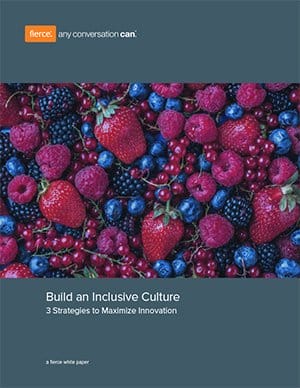During the quest for self-improvement, the age-old struggle I often find myself thinking about time and time again is, how do you adopt new behaviors AND make lasting change?
This is the quandary for learning and development departments, tasked with supporting their organizations on how to be more productive, more engaged — happier even — by having employees learn new skills and behaviors and have a system in place that supports long-lasting sustainable change.
The theory is organizations invest in their people through training and reap the rewards of employees who produce more with their heads and hearts engaged. This theory, I would argue, is 100 percent correct, and companies would be better off if they invested more in their people in this way, but one critical piece missing is that we have to redefine a word — training.
WHY REDEFINE TRAINING?
Training is not a one-time event. It’s an on-going experience that involves multiple touch points as individuals go down the hard path of change.
In the last decade, there has been a lot of research on creating behaviors and learning new skills, such as the scary fact that PEOPLE WILL FORGET 90% OF WHAT THEY’VE LEARNED AFTER ONE MONTH. It’s true what they say — if you don’t use it, you lose it!
We know more about the brain and its emotional nature than we ever have before and yet this question, how do you make behavior changes stick, still is a big blue ocean of possibility.
My goal in this blog isn’t to say we have a definitive answer, but to rather help guide your thinking and provide some helpful insight on proven ways we know that support your people on their behavior change journey in order to maximize the company’s investment and your time.
The end goal? Sustainable behavior change.
TIPS TO MAXIMIZE LEARNING
Below are four actionable ways to make the learning stick:
1. Spot the Cue
Learning a new behavior can be like one of those I Spy pictures, where you don’t see the object until someone points it out to you, and then it becomes so obvious.
At Fierce, our data shows that most learners leave the classroom excited to flex their new muscles and yet, what we have heard before from Learning and Development leaders, is that once back immersed into their daily lives, old behaviors start to creep in.
This is when touch points can be critical in setting up your employees for success. For example, with Fierce Conversations, we advise our clients to prompt cues as to when the business wants their learners to use the new skillset.
We’ve had clients ask leaders to use our Coaching model in at least one 1:1 every month. Furthermore, in both our Confront and Feedback model, we spend time in the classroom identifying what conversations are appropriate for what situations and we have the learners identifying conversations they need to have and start the process in the training.
By spending time as a learning team identifying what business results would be better if certain conversations improved and then messaging that back out to your learners, you make identifying the cue of this new behavior so much easier.
2. Simplicity is King
Let’s be honest, in today’s world of Twitter and Instagram, anything that takes more than 160 characters to understand is almost too complicated. While I am all for fighting back against our modern lack of attention span, I think what we can learn from social media is that simpler is sometimes better when you want to make something sticky.
At Fierce, none of our frameworks have more than seven steps or take longer than one page to fill out. The brain can memorize it and, in fact, is designed to be deconstructed even further and made even more simple once you learn the skill set.
We Delegate at four levels, we Coach with just seven simple questions, you can Confront in 60 seconds and make big decisions with your team’s input by filling out one page of information.
The depth comes from the quality of the conversation that arises from the simplicity of the approach. If you make the skillset easy, it becomes a routine that can be applied and followed. Before you know, it’s happening all the time.
3. Make it Worth It
Even the most avid learner has to see the value in spending their time in order to learn and apply something new. People don’t do things without a clear why. When it comes to behavior change, if that why isn’t there, it doesn’t matter if your previous two steps are flawless, you won’t get a commitment. Period.
As learning and developing professionals, you can’t control someone’s intrinsic why. However, at Fierce, we have a few best practices we’ve seen clients leverage with great success to support the reward of using are:
- Tie the why of the training to the larger business strategies and organizational goals. Nobody likes to feel like they’re wasting their time. This best practice ties back to tip number 1 — by helping people understand the why behind the training in the context of the company, they better see themselves supporting those goals and seeing what’s in it for them to make the effort for the change.
- Give champions the chance to share their reward and wins. Inevitably, you will have people who adopt the behavior quicker and you want to give them a platform to share their win. Collective wins can be powerful and having a colleague you respect share how this has positively impacted them can be the best motivators for others to try.
- Literally have a reward! Whether the reward is monetary or recognition, sometimes an external reward helps people focus until other more intrinsic rewards make themselves known.
4. Choose a Training Provider that focuses on Reinforcement
Not every training provider prioritizes the pre or post experience, whether that’s through technology, tools, or strategy, you should partner with someone who has a strong point of view on adoption and sustaining the learning.
At Fierce, we prioritize this with our clients by looking at the bigger picture of continuous change in a strategic way. Pre-training, during the training, and post-training all have an impact on learners prioritizing and changing the quality of their conversations.
When you apply these steps to your learning initiatives, you’ll not only increase the chances of your investment in training being successful, but you’re setting your entire organization up for sustainable and meaningful achievement.

ALIGN VALUES AND BEHAVIORS IN YOUR COMPANY
Start by building an inclusive workplace culture
Tags: #Cultural Change, #Inadequate Training, #Sustainability






